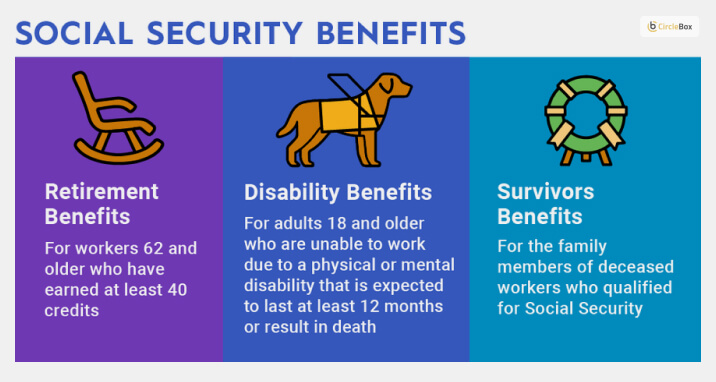The Old-Age, Survivors, and Disability Insurance (OASDI) programme, which is managed by the Social Security Administration (SSA), a government agency, also known as the “Social Security Office” in the United States. Although it’s most recognized for its retirement, disability, and survivor benefits, it offers income for handicapped employees and survivor benefits.
Approximately 71 million Americans received benefits as of December 2022. Let’s examine the functions of the office of Social Security and the money you may anticipate getting from it.
How Does The Social Security Office Work?
The Social Security Office programme offers insurance. Employees mostly contribute to the programme, usually through payroll withholding at their employment. While filing their federal tax returns, self-employed individuals must pay Social Security taxes.
A maximum of four times the credits can be earned by employees annually. Up until $6,000, or four credits, are earned in 2022, one credit is awarded for every $1,510 earned. This ranges from $1,600 to $6,500 in 2023.
Both the Old-Age and Survivors Insurance Trust Fund (OASI) for retired people and the Disability Insurance Trust Fund (DI) for beneficiaries with disabilities get this money. It’s then used to pay qualified members. The trust funds continue to store any extra unused funds.
Two different Social Security trust funds’ financial management is under the leadership of a board of trustees. The commissioner of Social Security and the secretaries of the Labor, Treasury, and Health and Human Services make up four of the six members. The last two members are elected officials nominated by the president and approved by the Senate.
Payroll withholding is also used to fund Medicare, a government health insurance programme for Individuals 65+ persons with disabilities. The Centers for Medicare & Medicaid Services, who are in charge of managing the third trust fund, receives this money (CMS).
Primary Benefits Provided By The Social Security Office

The primary benefits provided by the Social Security Office are:
1. Retirement Benefits
At age of 62, workers who have contributed to the Social Security Office for a minimum of ten years can receive early retirement benefits. More monthly payments are obtained by delaying retirement until you reach “FRA (Full Retirement Age), which ranges from the ages of 66 to 69. Retirement benefits don’t rise if you wait after 70. But if you do wait wait till 70, your benefits will grow.
Also, spouses are eligible to apply for benefits depending on their own income or their spouse’s earnings history. If you were married for ten years, a divorced spouse who is not presently married may be eligible for benefits based on an ex-economic spouse’s history.
Children of retirees are also eligible for benefits up to the age of 18, or longer if they are handicapped.
The amount of your Social Security Office retirement benefit is based on your average indexed monthly earnings (AIME) during the employment period of highest income.
Therefore, the amount received will vary greatly among retirees. As of December 2022, the monthly benefits was $20,200 per year.
Starting at age 61 and ending at age 69, your annual amount increases annually by 8% if you postpone getting benefits. Therefore, the benefit varies according on its starting date.
The maximum monthly benefit in 2023 is $2,572 for those 62 and older ($30,800 yearly), and $4,500 for those 70 and older ($54,600 annually).
In order to keep up with inflation, Social Security payouts are also adjusted yearly for cost of living. It will rise by 8.7% in 2023.
2. Disability Benefits
Social Security Office disability payments may be available to those who are unable to work owing to a physical or mental impairment that is anticipated to endure for a year or till death. You might have to pass certain income requirements to qualify. Families of disabled employees may qualify.
Approximately 9 million People were receiving SSDI as of December 2022. The typical benefit was $1,340.86 per month ($16,090.32 yearly). The average monthly wage for handicapped employees was $1,483.10 ($17,797.20 yearly). The average monthly salary for spouses of crippled employees was $408.42 ($4,901.04 annually), while the average monthly salary for children of disabled workers was $470.77 ($5,649.24 annually).
3. Survivor Benefits
Depending on the earning history of the employee, the surviving family members of the deceased employee may receive survivor benefits. So as long as they haven’t remarried, this also applies to surviving spouses above 60 years of age, or 50 years or older and handicapped. These payments may also be available to a surviving spouse taking care of a handicapped or kid under the age of sixteen.
Children must often be under 18 years of age, or handicapped, to qualify for benefits. Stepchildren, grandchildren, step-grandchildren, or adopted children are also eligible for benefits in certain situations.
Parents who were 61+ years of age and relied on 50% of a dead worker’s income may also be eligible. With the death of a qualified employee, surviving spouses and minor children may also get a single payment of $250 each.
As of December 2022, 5.68 million people received survivor benefits from the Social Security Office. The typical benefit was $1,447.08 per month ($17,364.96 annually). Five categories makeup survivor benefits. The typical payouts were:
- Children of employees who have passed away: $1,067.36 per month ($12,808.00 per year)
- Widowed parents: $1,231.86 per month ($14,782.32 per year)
- Widow(ers) without disabilities: $1,705.27 per month ($20,463.24 per year)
- widows who are disabled: $892.87 per month ($10,714.44 yearly)
- Parents of employees who have passed away: $1,537.98 per month ($18,455.76 yearly)
Conclusion
The Old-Age, Survivors, and Disability Insurance (OASDI) programme, which is managed by the Social Security Administration (SSA), a government agency, is referred to as the “Social Security Office” in the United States. Although it is most “recognized” for its retirement, disability, and survivor benefits, it also offers income for handicapped employees and survivor benefits.
Read Also:

